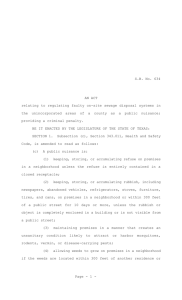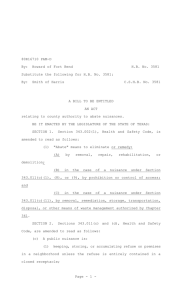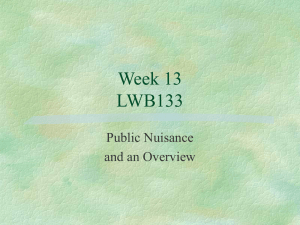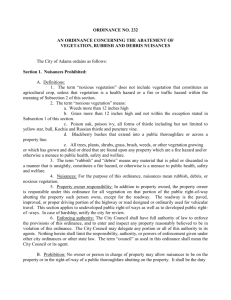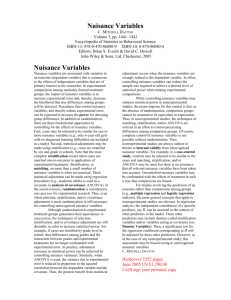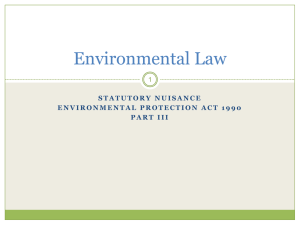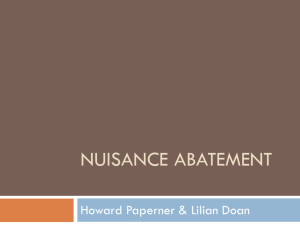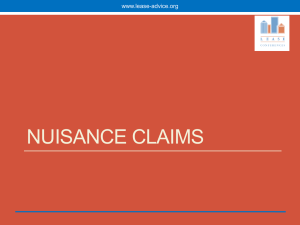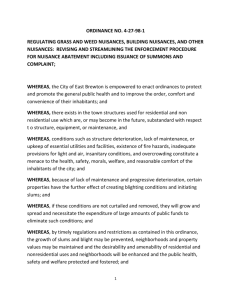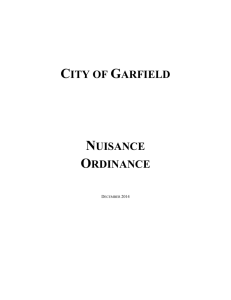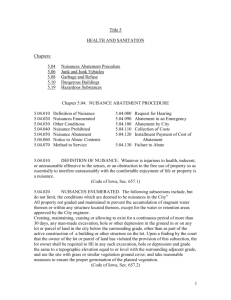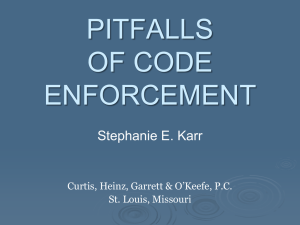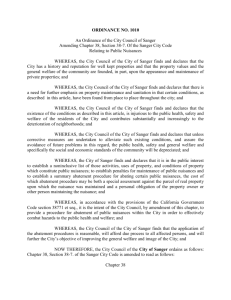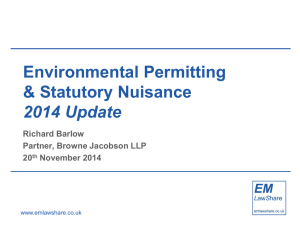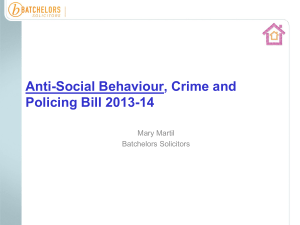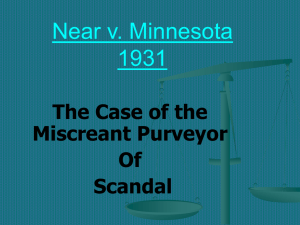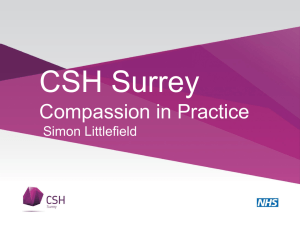Nuisance Abatement
advertisement
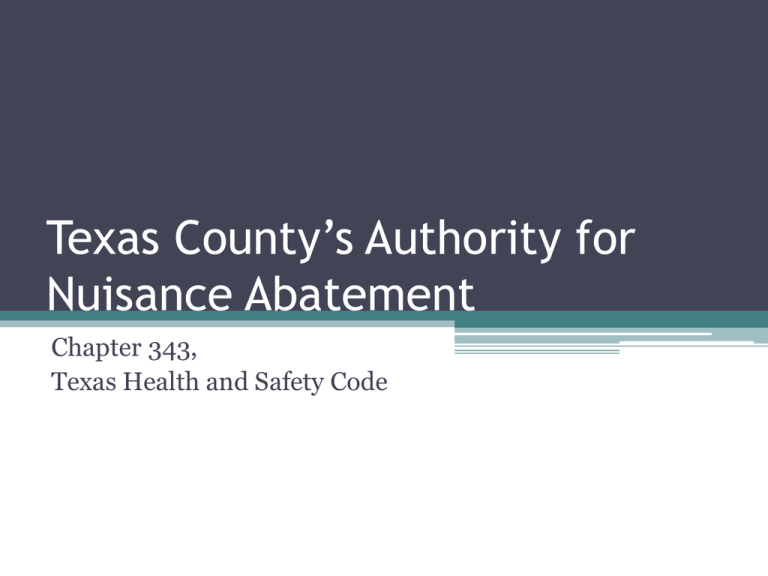
Texas County’s Authority for Nuisance Abatement Chapter 343, Texas Health and Safety Code Statutory Authority • Texas Counties are creatures of limited authority. Must be able to show affirmative grant of express authority for nuisance abatement. ▫ Canales v. Laughlin, 214 S.W. 2d 451 (Tex. 1948) • Chapter 343, Health and Safety Code provides Texas counties express authority for nuisance abatement. Definition of Abate-343.002 THSC • Abate means to eliminate or remedy: ▫ By removal, repair, rehabilitation or demolition; or ▫ In the case of public nuisances, by prohibition or control of access. ▫ In cases of discarded refuse, by removal, remediation, storage, transportation, disposal, or other means of waste management authorized by Chapter 361, Texas Health and Safety Code. (Solid Waste Disposal Act) Neighborhood Defined343.002(4) THSC • Neighborhood means: ▫ A platted subdivision, or ▫ Property contiguous to and within 300 feet of a platted subdivision. Platted subdivision means an approved or unapproved plat of the subdivision filed with the county clerk. No case on purely “unauthorized” subdivision without plat filed of record. Argument could be made that illegal dumping within 300 fee of an unauthorized subdivision would still be a violation of health and safety code. Public Street defined343.002(7) THSC • Public street means the entire width between property lines of a road, street, way, thoroughfare, or bridge if any part of the road, street, way, thoroughfare, or bridge is open to the public for vehicular or pedestrian traffic. Control of Public Nuisance (Refuse or Rubbish) • Applies only to unincorporated areas of county. • Public nuisance defined as: ▫ Keeping refuse in a neighborhood outside of a closed receptacle; or ▫ Keeping, storing or accumulating rubbish in a neighborhood, or within 300 feet of a public street for 10 days or more, unless enclosed or out of sight from street. Public Nuisance (pests and weeds) • A public nuisance is: ▫ Maintaining premises in a manner that creates an unsanitary condition likely to attract or harbor mosquitoes, rodents, vermin, or disease-carrying pests. ▫ Allowing weeds over 36” to grow in a neighborhood on premises located within 300 feet of another residence or commercial establishment. Public Nuisance-Structures 343.011(5) THSC • A public nuisance is: ▫ Maintaining a building in a manner that is structurally unsafe or constitutes a hazard to safety, health, or public welfare…(disaster damage, fire hazard) ▫ Unoccupied property in a neighborhood containing a swimming pool not protected by a fence at least four feet high with latched and locked gate, and a cover over the entire pool that cannot be removed by a child. (Younger than 14 based on Criminal law definition) Public Nuisance-Public Land • A Public Nuisance is: ▫ Discarding refuse or creating a hazardous visual obstruction on county owned land, or held by a special district under control of county court. ▫ Discarding refuse 20 feet on either side of a utility line, or the actual span of a utility easement. ▫ Filling or blocking a drainage easement, or ▫ Public dumping on land that is not approved for such activity. Section does not apply to solid waste dump, or to agricultural land. (Tax Code) Variances-by Commissioners Court • Court may describe circumstances in which exceptions may be granted, and the special exception promotes justice, is not contrary to public interest, and is consistent with general purposes of nuisance abatement (grandfather clause for existing landfill or wrecking yards, for example) • The Court must define the exception and keep records of applications for variance and ruling on application. Enforcement Powers-Criminal Penalty • A person commits a violation if the nuisance remains unabated after the 30th day after which the person receives notice from a county official, agent, or employee to abate the nuisance. • $50-200.00 fine for 1st offense. • Previous conviction will increase range of fine to $200-1000.00, and jail confinement for not more than six months, or both. • Each day a separate offense. • Court may order abatement upon conviction. Enforcement-Injunction • A county or district court may by injunction prevent, restrain, abate or otherwise remedy a violation of this chapter in the unincorporated area of the County. • A county or person affected by a violation of this chapter may bring suit to abate nuisance. • Reasonable attorneys fees can be recovered. County Injunction Action • County must establish: ▫ Person responsible for condition has not responded to prior attempts to abate the nuisance. ▫ Owner of premises (if different) actually knows of nuisance, and has not responded to prior attempts. ▫ Cannot interfere with utility access, nor interfere with efforts by landowner to abate. Commissioners Court Abatement • County must adopt abatement procedures consistent with the general purpose of Chapter 343. • County may demolish or remove, or prohibit or control access to premises. • Procedures must be administered by a regularly salaried, full-time employee. Minimum Due Process Standards • Administrator must: ▫ Give written notice of any alleged nuisance to: Owner, lessee, occupant, agent or person in charge of the premises, and The person responsible for causing a public nuisance when that person is not the owner, lessee or lessor, occupant, agent or person in charge of the premises, and the person responsible can be identified. Notice Requirements ▫ Notice must state the specific condition that constitutes a public nuisance, and give notice that the person receiving notice has at least 31 days to abate the nuisance. (As little as 10 days if prior notice given) ▫ Failure to abate may result in: County abatement Assessment of costs Lien against property Additional Notice Requirements • That County may prohibit or control access to the premises to prevent continued or future nuisance, and • That the person receiving notice is entitled to submit a written request for hearing before the 31st day after the date on which the notice is served, or the 10th day if a prior notice has been issued. • Notice must be in person or by registered or certified mail, return receipt requested, or by publication. Hearing Requirements • Hearing must be held before County abated the nuisance if a hearing is requested. • Hearing may be by Commissioners Court, or any board, or official designated by the Commissioners Court. • Swimming pools can be abated immediately, but a hearing must be held after abatement. Assessment of Costs • A county may: ▫ Assess the cost of abating the nuisance, including management, remediation, storage, transportation, and disposal costs, and damages and other expenses incurred by the County; ▫ Cost of legal notice, and ▫ Administrative fee of not more than $100.00 ▫ Must be able to prove written notice before assessment of costs. Imposition of Lien • File a notice with Statement of Costs, a legal description of the property “sufficient to identify the property”, with the name of the property owner, with the Clerk of the County in which the property is located. • Lien attaches when the Notice of Lien is filed, and is inferior to a previously recorded bona fide mortgage lien. • County is entitled to interest at 10% beginning on the 31st day after the date of lien attachment. Miscellaneous • County may use any available county funds to abate nuisance. (line item transfer recommended) • Access to property is expressly granted to any county official, agent or employee to inspect, investigate or abate a nuisance during reasonable times. • Agent must exhibit proper identification to any occupant or other appropriate person. • General equitable powers for enforcement extended by court.
